transmission NISSAN GT-R 2021 Owners Manual
[x] Cancel search | Manufacturer: NISSAN, Model Year: 2021, Model line: GT-R, Model: NISSAN GT-R 2021Pages: 1808, PDF Size: 4.88 MB
Page 29 of 1808
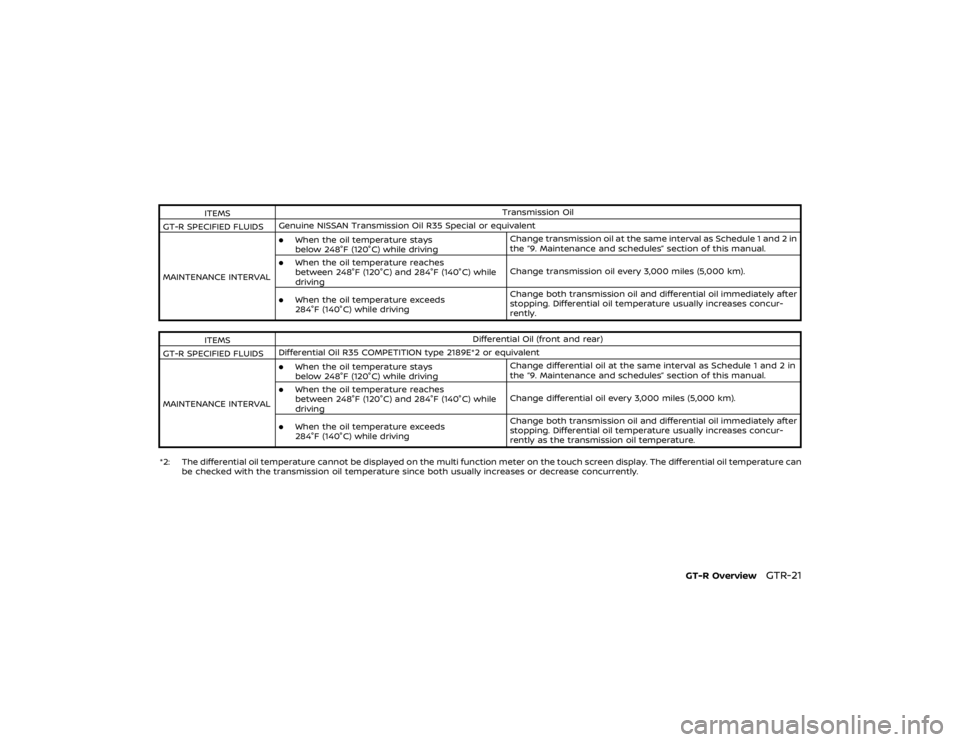
.
NOTE:
Do not keep the starter motor en-
gaged for more than 10 seconds. If
the engine does not start right away,
push the ignition switch to the OFF
position and wait 10 seconds before
trying again.
7. After starting your engine, carefully disconnect the negative cable and
then the positive cable (
?
?“Removing the cowl top cover”
page 8-5) Do not attempt to start the engine by
pushing.
NOTICE
Your NISSAN cannot be push-started
or tow-started. Attempting to do so
may cause transmission damage.
WARNING
.
Do not continue to drive if your
vehicle overheats. Doing so could
cause engine damage or a vehicle
fire.
. To avoid the danger of being
scalded, never remove the radia-
tor filler cap and the coolant
reservoir cap while the engine is
still hot. When the cap is removed,
pressurized hot water will spurt
out, possibly causing serious in-
jury.
. Do not open the hood if steam is
coming out.
If your vehicle is overheating (indicated by
an extremely high temperature gauge
reading), or if you feel a lack of engine
power, detect unusual noise, etc., take the
following steps:
1. Move the vehicle safely off the road, apply the parking brake and move the
shift lever to the
position.
Do not stop the engine.
2. Turn off the air conditioner. Open all the windows, move the temperature
control to maximum hot and fan
PUSH STARTING IF YOUR VEHICLE OVERHEATS
Page 50 of 1808

However, the brake pads can be sepa-
rately replaced only when a GT-R certified
technician judges that the brake disc
rotors are reusable, based on a measured
weight and a check for scratches and
cracks.EXHAUST MUFFLER AND TRUNK
CARPETThe GT-R exhaust system is designed to
provide the maximum vehicle perfor-
mance and to protect the vehicle from
high exhaust gas temperatures.
If non-genuine GT-R exhaust system
parts are used it is possible that the
muffler or other exhaust system parts will
deform and cause damage to the under-
body. Non-genuine GT-R exhaust system
parts can also affect vehicle performance
and possibly lead to turbocharger, engine
or power train related parts including
transmission, damage.
Also, do not remove the trunk carpet from
the vehicle for any reason. The carpet
insulates the vehicle interior from the
heat of the muffler and from the noise
of the transmission.
TITANIUM MUFFLER AND TRUNK
CARPET (if so equipped)
NOTICE
Never allow polishes with com-
pounds, because there is a possibi-
lity that the titanium muffler finisher
coloring will be changed.
GT-R Overview
GTR-7
Page 56 of 1808
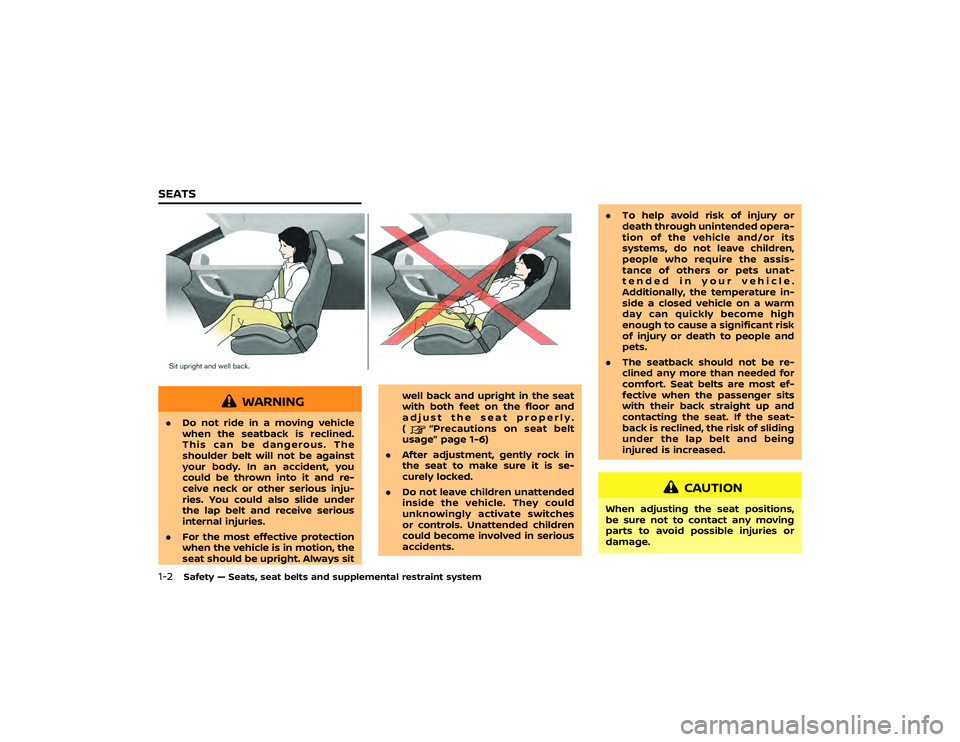
position.
. Transmission oil temperature is 284°F
(140°C) or higher:
If the transmission oil temperature
increases to over 284°F (140°C), the
color of the meter display changes to
red. However, the vehicle can continue
to be driven until the temperature
reaches 295°F (146°C). If the oil tem-
perature exceeds 284°F (140°C) while
driving (the color of the meter dis-
played in red), change both the trans-
mission oil and the differential oil after
driving because these fluids have
deteriorated because of the heat.
GT-R Overview
GTR-13
ADDITIONAL MAINTENANCE ITEMS
Page 57 of 1808

Cool downThe information and specifications in
this section apply only when engaging
in performance driving.
Cool down the vehicle to help extend the
life of the vehicle if coolant temperatures
are extremely high. Drive the vehicle at 37
to 50 MPH (60 to 80 km/h), in 5th or 6th
gear for 2 to 3 miles (3 to 5 km) and then
stop the engine.Refueling precautions
WARNING
Do not attempt to top off the fuel
tank after the fuel pump nozzle
shuts off automatically. Continued
refueling may cause fuel overflow,
resulting in fuel spray and possibly a
fire. The fuel tank is full at the first
automatic shutoff.
To maximize vehicle performance, the
fuel tank is located as low as possible to
lower the vehicle center of gravity. The
tank is also divided into two parts. This
fuel tank design causes higher pressures
inside the tank than other vehicles so fuel
spillage is possible by trying to top off the fuel tank after automatic shutoff.
The fuel tank pressure is higher when the
vehicle is hot, especially if the tank is more
than half full. If the cap is opened when
the vehicle is hot, it may cause fuel spray
and there may be a hissing noise. Open
the cap slowly, releasing the pressure
from the tank gradually. Also, if the
vehicle is refueled when the vehicle is
hot, the fuel pump may automatically
shut off before the tank is full. This does
not indicate that there is a malfunction.
Refuel slowly or refuel after the vehicle
has cooled.
INSPECTION AND ADJUSTMENTS
BEFORE DRIVINGThe information and specifications in
this section apply only when engaging
in performance driving.Fluids.
Check the engine, transmission, differ-
ential and under vehicle surfaces for
oil and coolant leaks.
. Check the fluid levels and adjust as
necessary using the specified fluid as
described under the conditions listed
in this section.(
“Recommended
fluids and maintenance interval” page GTR-20) If you do not drive under the
conditions listed, refer to the “9. Main-
tenance and schedules” section of this
manual.
Page 59 of 1808
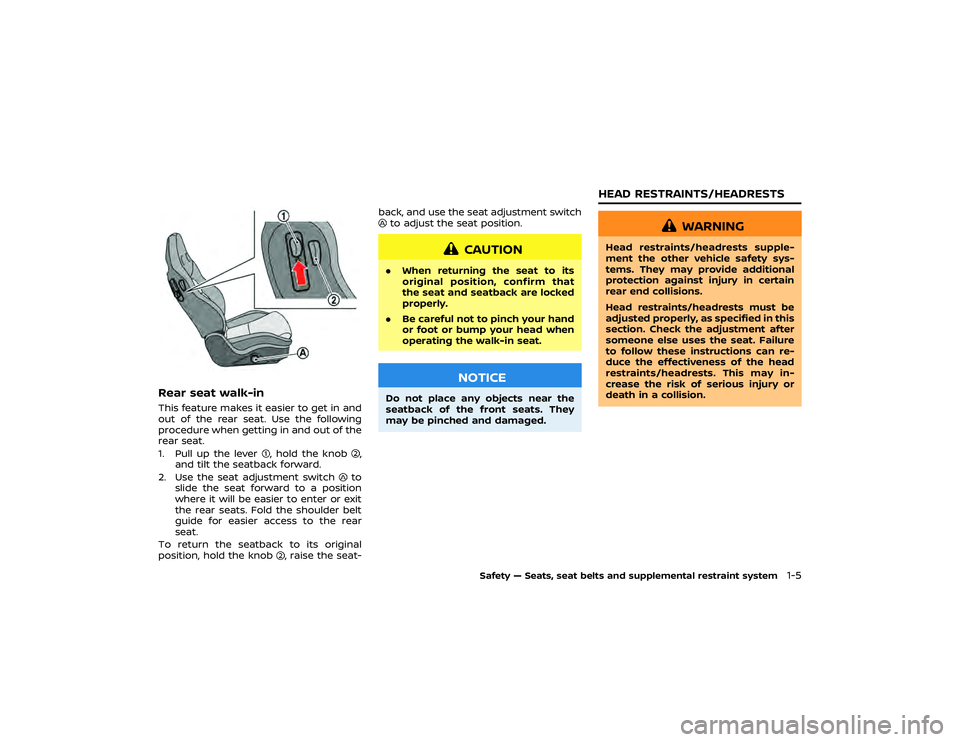
Check the coolant level in the pressurized
coolant reservoir. Adjust the level so that
the fluid is between the MAX and MIN
markings. For the coolant, use genuine
NISSAN Long Life coolant or equivalent.
(On delivery of new vehicle, the reservoir
is filled to the MIN level. Be sure to
replenish approximately 3/8 US quart
(0.3 to 0.4 liter) of coolant.)
NOTICE
Do not overfill the coolant. This may
increase the pressure in the cooling
system and cause coolant leaks.
To maximize vehicle performance, the
coolant mixture ratio should be a combi-
nation of 30% coolant antifreeze and 70%
demineralized or distilled water for max-
imum cooling system performance re-
gardless of ambient temperatures.
If ambient temperatures are anticipated
below 5°F (−15°C), make sure a proper
mixture ratio of 50% antifreeze and 50%
demineralized or distilled water mix is
used.Engine and powertrainThe information and specifications in
this section apply only when engaging in performance driving.
.
Check the engine, transmission, differ-
ential and under the vehicle for oil and
coolant leaks.
. Inspect the areas surrounding of the
catalytic converter for heat deteriora-
tion.
. Always perform the transmission
setting. After that, adjust the clutch
clearance so that the clearance is less
than the clearance used for daily
driving. Your GT-R certified NISSAN
dealer has the necessary information
and equipment to set the clutch
clearance to the correct specification.
The clearance used for daily driving
increases clutch heat generated dur-
ing Performance Driving. This leads to
an increase in temperature of the
transmission oil. In addition, a more
direct shifting feel can be obtained by
reducing the clutch clearance for
Performance Driving. The clutch clear-
ance should be reset to the daily
driving specification after Perfor-
mance Driving. It is recommended
you see a GT-R certified NISSAN dealer
for information.
NOTICE
Failure to have the clutch properly
adjusted before performance driving
may cause the transmission oil tem-
perature to increase which may
cause transmission damage.
. Inspect and confirm the clearance
between the exhaust finisher and rear
bumper is more than 0.24 in (6 mm)
(up/down) and more than 0.20 in (5
mm) (left/right).
. Inspect the dust boot of the drive
shaft universal joint for cracks or
damage.Suspension and wheel alignmentThe information and specifications in
this section apply only when engaging
in performance driving.
.Check the steering and suspension
system and other links for loose and/
or damaged parts.
. Measure and adjust the wheel align-
ment. (
“Wheel alignment” page
GTR-10) It is recommended you con-
tact a GT-R certified NISSAN dealer to
adjust the wheel alignment to the
recommended setting for high perfor-
Page 62 of 1808

in this section for 48 hours after tires
are installed on the wheels. The tire
may slip on the wheel if the vehicle is
driven in these conditions before 48
hours have passed. If the tire slips on
the wheel, the wheel/tire assembly
will be out of balance and will require
rebalancing.
BrakesThe information and specifications in
this section apply only when engaging
in performance driving.
.Check for the heat deterioration of the
brakes and parts around the brakes.
. It is recommended that you remove
air from the brake system after any of
the following:
— When engaging in high perfor-
mance driving for the first time
after purchasing a new vehicle.
— After replacing the brake fluid.
— When engaging in high perfor- mance driving for a sustained per-
iod of time. It is recommended that
bleeding the brake be performed
when the brake calipers are hot
(about 212°F (100°C)). Brake pad break-in procedure:
NISSAN recommends that a special brake
pad break-in procedure be performed
before engaging in performance driving.
It is recommended you contact a GT-R
certified NISSAN dealer for details.
INSPECTION AND ADJUSTMENTS
AFTER DRIVINGThe information and specifications in
this section apply only when engaging
in performance driving.
NOTICE
At the completion of performance
driving, all fluid and other adjust-
ments should be returned to the
normal fluid specifications as shown
in the “8. Do-it-yourself” section of
this manual.FluidsThe information and specifications in
this section apply only when engaging
in performance driving.
.
Check the engine, transmission, differ-
ential and under the vehicle for oil and
coolant leaks. .
Check the fluid levels and adjust as
necessary using the specified fluid as
described under the conditions listed
in this section. (
“Recommended
fluids and maintenance interval” page
GTR-20) If you do not drive under the
conditions listed, refer to the “9. Main-
tenance and schedules” section of this
manual.
. When changing fluids, be sure to use
the specified fluids as described in this
Owner’s manual. (“Capacities and
recommended fluids/lubricants” page
10-2)
GT-R Overview
GTR-19
Page 75 of 1808
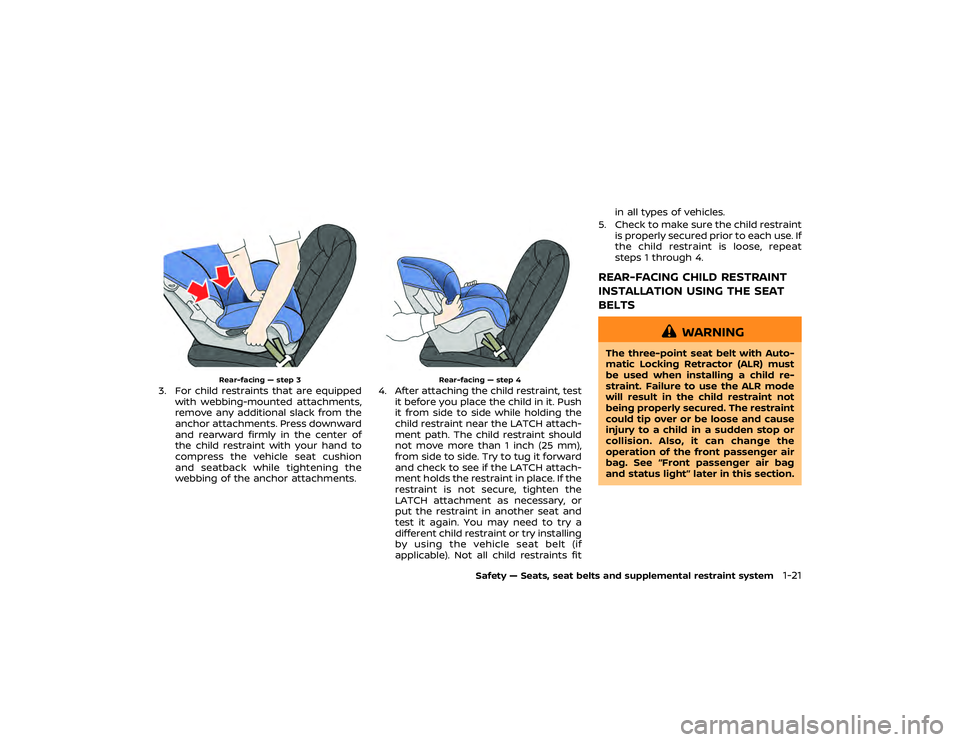
to
position before the vehicle stops, you may not be able
to shift gear or it may take longer to shift gear. Make sure to depress the brake pedal and check that the vehicle has
stopped before shifting.
Multiple-disc wet
clutch
.
When stopping the vehicle with the shift lever in the
orposition. Move the shift lever after turning off the system check
display. Also, it is normal to hear clicking noises during the transmission systems check.
Changing modes
.
The higher shift speeds in the
position may result in shift shock and jerkiness when starting or shifting.
.
The quickest shifting in the R mode with the transmission in the
position is available when the engine speed is high.
However, the transmission may shift more slowly when the engine speed is low.
Mechanical Limited Slip
Differential (LSD) If the vehicle accelerates from a stop with the steering wheel turned half a turn in cold temperatures, the inner wheel tire
may slip and some noise or vibration may be heard. This phenomenon occurs because the viscosity of the differential oil
becomes thicker and the Limited Slip Differential (LSD) operates with increasing load. When the steering wheel is returned
to the straight ahead position or the differential oil warms up, the noise and vibration decrease.
Page 94 of 1808

NOTICE
.When the temperature of the
engine coolant and transmission
oil is high or low, the function
cannot be used. The temperature
range in which the R mode start
function can be used:
— Engine coolant: 140°F - 212°F
(60°C - 100°C)
— Transmission oil: 140°F - 266°F (60°C - 130°C)
. If the R mode start function is
used 4 times consecutively, the
function may be disabled and
cannot be turned on to protect
the vehicle system. While the function is disabled, the warning
light illuminates. When the warn-
ing light illuminates, perform cool
down driving. (
“Cool down”
page GTR-14) When the warning
light turns off, the function can be
used again.
. The performance of start may
vary depending on the amount
of wheel spin ,or increase and
decrease of the engine output in
response to the outside tempera-
ture. (This vehicle was set up
according to the road surface
conditions of the straight sec-
tions of the Sendai Highland Ra-
ceway course in Japan at 59°F
(15°C).)
. For safety reasons, VDC control
may activate automatically when
driving on a slippery road surface,
such as a wet road, in order to
apply the brakes or limit the
engine output.
. Frequent use of the R mode start
function increases the load on
the powertrain related parts such
as the clutch and transmission
compared to normal driving. In
particular, the clutch will wear out
Starting and driving
5-33
R MODE START FUNCTION
Page 96 of 1808

Do not use the cruise control when
driving under the following condi-
tions. Doing so could cause a loss of
vehicle control and result in an acci-
dent.
.When it is not possible to keep
the vehicle at a set speed.
. In heavy traffic or in traffic that
varies in speed.
. On winding or hilly roads.
. On slippery roads (rain, snow, ice,
etc.).
. In very windy areas.
NOTE:
. When the SAVE mode is selected
with the transmission setup switch,
the acceleration and deceleration
can be controlled smoothly. When
the SAVE mode is selected, the
maximum setting speed is lower
than the one in the normal mode. When the vehicle approaches a gen-
tle uphill, there may be a slight delay
as the vehicle returns to the preset
speed. However, the vehicle will
gradually accelerate and return to
the preset speed.
PRECAUTIONS ON CRUISE CON-
TROL.
If the cruise control system malfunc-
tions, it will cancel automatically. The
SET indicator will blink and the cruise
control system warning will appear to
warn the driver. (
“Cruise control
system warning” page 2-43)
. If the engine coolant temperature
becomes excessively high, the cruise
control system will be canceled auto-
matically.
. If the SET indicator blinks, turn the
cruise control main switch off and it is
recommended you contact a GT-R
Starting and driving
5-35
CRUISE CONTROL
Page 100 of 1808
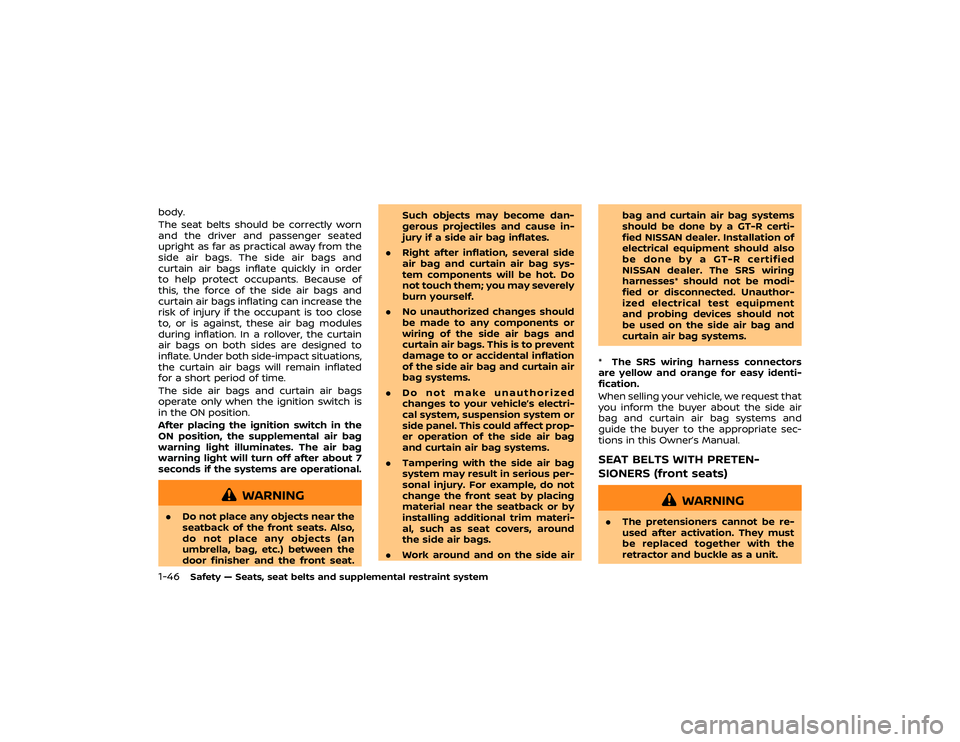
NOTICE
When the vehicle is stopped on a hill,
do not hold the vehicle in place by
depressing the accelerator pedal.
Doing so may cause the clutch to
overheat and result in transmission
damage. Use the brakes to prevent
the vehicle from moving.
The hill start assist system automatically
keeps the brakes applied to help prevent
the vehicle from rolling backwards in the
time it takes the driver to release the
brake pedal and apply the accelerator
when the vehicle is stopped on a hill.
Hill start assist will operate automatically
under the following conditions:
. The shift lever is moved to a forward
or reverse position.
. The vehicle is stopped completely on a
hill by applying the brake.
The maximum holding time is 2 seconds.
After 2 seconds the vehicle will begin to
roll back and hill start assist will stop operating completely.
Hill start assist will not operate when the
shift lever is moved to the
or
position
or on a flat and level road.
NOTE:
This system does not function when the
Vehicle Dynamic Control VDC) system
warning appears on the vehicle infor-
mation display located in the tach-
ometer. (
“Vehicle Dynamic Control
(VDC) system warning” page 2-40)Starting and driving
5-39
HILL START ASSIST SYSTEM